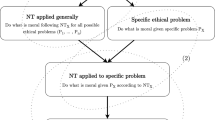Abstract
The Turing Test (TT) is claimed by many to be a way to test for the presence, in computers, of such ``deep'' phenomena as thought and consciousness. Unfortunately, attempts to build computational systems able to pass TT (or at least restricted versions of this test) have devolved into shallow symbol manipulation designed to, by hook or by crook, trick. The human creators of such systems know all too well that they have merely tried to fool those people who interact with their systems into believing that these systems really have minds. And the problem is fundamental: the structure of the TT is such as to cultivate tricksters. A better test is one that insists on a certain restrictive epistemic relation between an artificial agent (or system) A, its output o, and the human architect H of A – a relation which, roughly speaking, obtains when H cannot account for how A produced o. We call this test the ``Lovelace Test'' in honor of Lady Lovelace, who believed that only when computers originate things should they be believed to have minds.
Similar content being viewed by others
References
Boolos, G.S. and Jeffrey, R.C. (1989), Computability and Logic, Cambridge, UK: Cambridge University Press.
Bringsjord, S. (1991), 'Is the connectionist-logicist clash one of ai's wonderful red herrings?', Journal of Experimental & Theoretical AI 3(4), pp. 319–349.
Bringsjord, S. (1992), What Robots Can and Can't Be, Dordrecht, The Netherlands: Dordrecht, Kluwer.
Bringsjord, S. (1995), 'Could, how could we tell if, and why should-androids have inner lives?', in K. Ford, C. Glymour and P. Hayes, eds., Android Epistemology, Cambridge, MA: MIT Press, pp. 93–122.
Bringsjord, S. (1998a), 'Chess is too easy', Technology Review 101(2), pp. 23–28.
Bringsjord, S. (1998b), Philosophy and 'super' computation, in J. Moor and T. Bynam, eds., The Digital Phoenix: How Computers are Changing Philosophy, Oxford, UK: Blackwell, pp. 231–252.
Bringsjord, S. and Ferrucci, D. (2000), Artificial Intelligence and Literary Creativity: Inside the Mind of Brutus, a Storytelling Machine, Mahwah, NJ: Lawrence Erlbaum.
Bringsjord, S. and Zenzen, M. (2001), SuperMinds: A Defence of Uncomputable Cognition, Dordrecht, The Netherlands: Kluwer Academic Publishers.
Copeland, B.J. (1998), 'Turing's O-machines, searle, penrose and the brain', Analysis 58(2), pp. 128–138.
Ebbinghaus, H.D., Flum, J. and Thomas, W. (1984), Mathematical Logic, New York, NY: Springer-Verlag.
Gold, M. (1994), 'Limiting recursion', Journal of Symbolic Logic 30(1), pp. 28–47.
Harnad, S. (1991), 'Other bodies, other minds: A machine incarnation of an old philosophical problem', Minds and Machines 1(1), pp. 43–54. This paper is available online at ftp://cogsci.ecs.soton.ac.uk/pub/harnad/Harnad/harnad91.otherminds
Hofstadter, D. (1982), 'Metafont, metamathematics, and metaphysics', Visible Language 14(4), pp. 309–338.
Hofstadter, D. (1995), Fluid Concepts and Creative Analogies: Computer Models of the Fundamental Mechanisms of Thought, New York, NY: Basic Books.
Hofstadter, D. and McGraw, G. (1995), Letter spirit: Esthetic perception and creative play in the rich microcosm of the roman alphabet, in Fluid Concepts and Creative Analogies: Computer Models of the Fundamental Mechanisms of Thought, New York, NY: Basic Books, pp. 407–488.
Kafka, F. (1948), The metamorphosis, in F. Kafka, T.W. Muir and E. Muir, eds., The Penal Colony, New York, NY: Schocken Books.
Kugel, P. (1986), 'Thinking may be more than computing', Cognition 18, pp. 128–149.
Moor, J.H. (1976), 'An analysis of turing's test', Philosophical Studies 30, pp. 249–257.
Moravec, H. (1999), Robot: Mere Machine to Transcendant Mind, Oxford, UK: Oxford University Press.
Pollock, J. (1995), Cognitive Carpentry: A Blueprint for How to Build a Person, Cambridge, MA: MIT Press.
Putnam, H. (1994), 'Trial and error predicates and a solution to a problem of mostowski', Journal of Symbolic Logic 30(1), pp. 49–57.
Russell, B. (1936), 'The limits of empiricism', Proceedings of the Aristotelian Society 36, 131–150.
Russell, S. and Norvig, P. (1994), Artificial Intelligence: A Modern Approach, Saddle River, NJ: Prentice Hall.
Searle, J. (1980), 'Minds, brains and programs', Behavioral and Brain Sciences 3, pp. 417–424. This paper is available online at http://members.aol.com/NeoNoetics/MindsBrainsPrograms.html.
Siegelmann, H. (1995), 'Computation beyond the turing limit', Science 268, pp. 545–548.
Siegelmann, H. and Sontag, E. (1994), 'Analog computation via neural nets', Theoretical Computer Science 131 pp. 331–360.
Turing, A. (1964), Computing machinery and intelligence, in A.R. Anderson, ed., Minds and Machines, Englewood Cliffs, NJ: Prentice-Hall, pp. 4–30.
Weyl, H. (1949), Philosophy of Mathematics and Natural Science, Princeton, NJ: Princeton University Press.
Wos, L. (1996), The Automation of Reasoning: An Experimenter's Notebook with OTTER Tutorial, San Diego, CA: Academic Press.
Author information
Authors and Affiliations
Rights and permissions
About this article
Cite this article
Bringsjord, S., Bello, P. & Ferrucci, D. Creativity, the Turing Test, and the (Better) Lovelace Test. Minds and Machines 11, 3–27 (2001). https://doi.org/10.1023/A:1011206622741
Issue Date:
DOI: https://doi.org/10.1023/A:1011206622741




